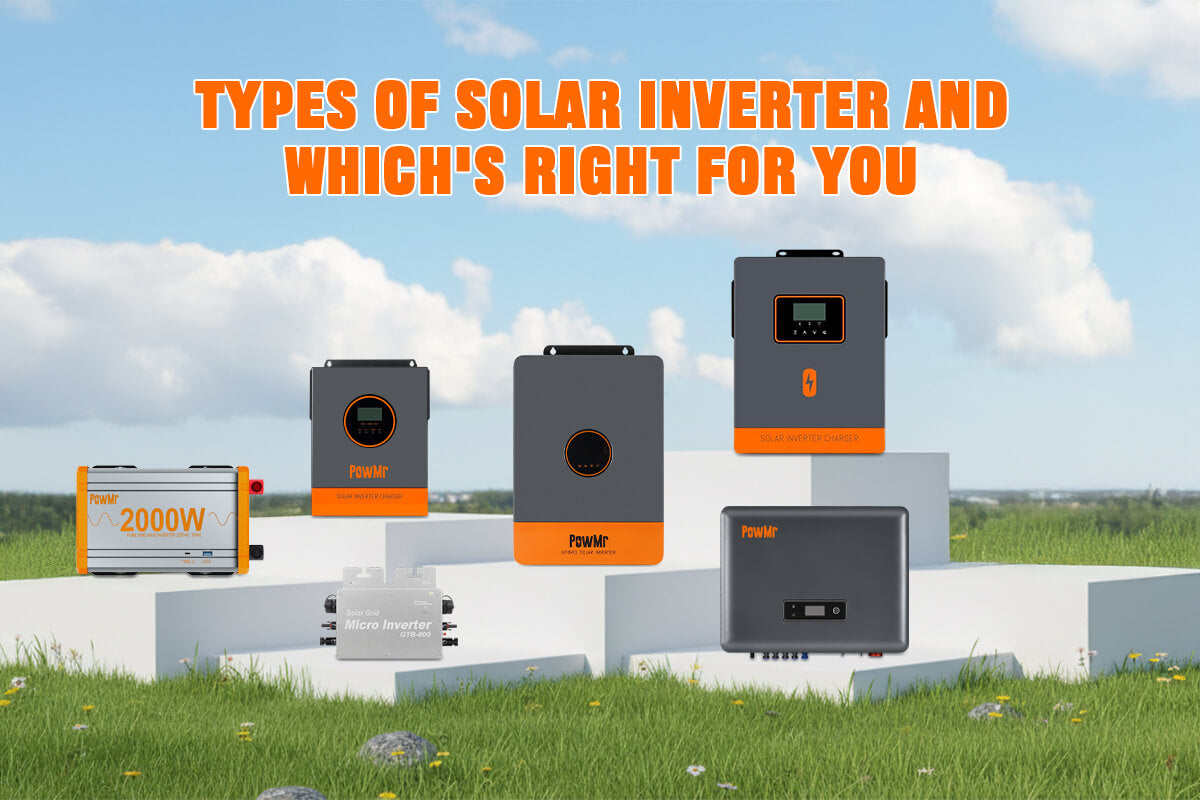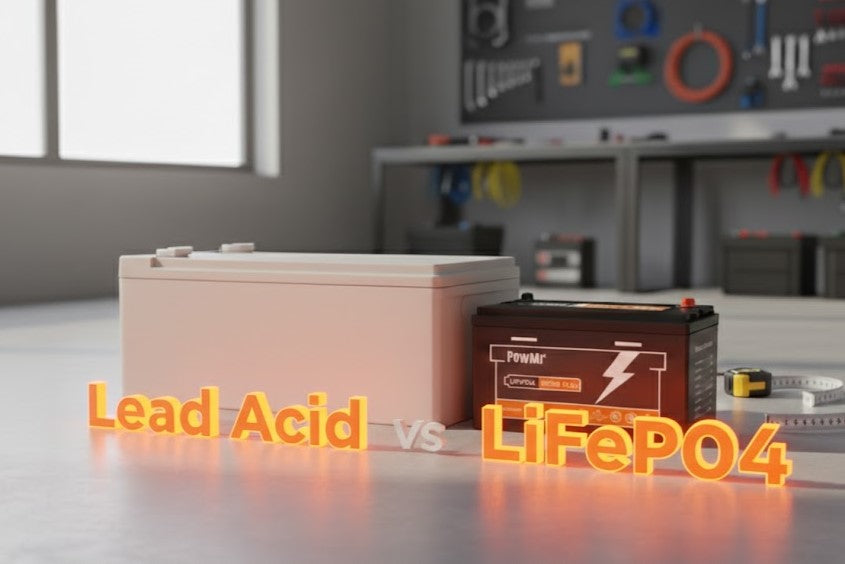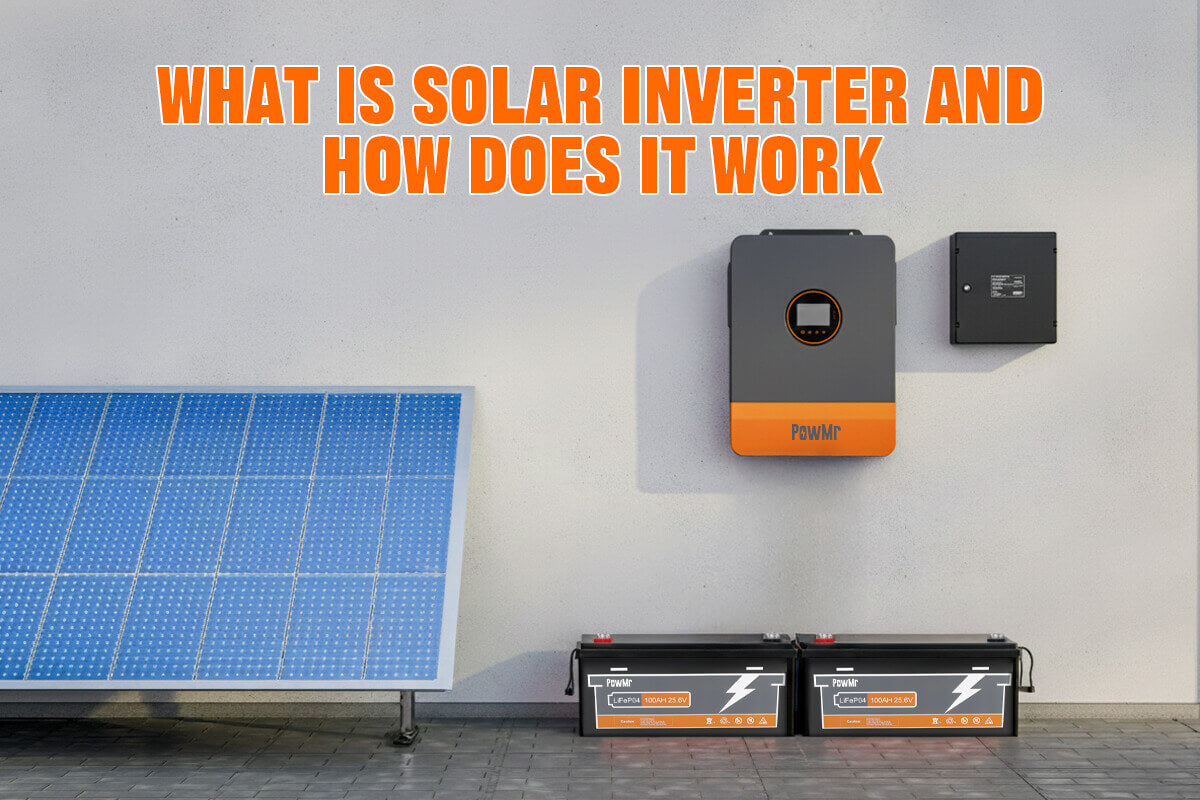If solar panels are the spotlight of a photovoltaic system, the solar inverter is its silent, intelligent brain, which governs how energy is generated, transmitted, and regulated, while also controlling system energy distribution to achieve your solar goals.
As solar technology matures, a wide variety of inverters flood the market, but which one is truly the best choice for you?
This guide will demystify the world of solar inverters. We'll start with the three main types every homeowner should know, then dive into the detailed classifications that separate good systems from great ones.
Quick Takeaway: The 3 Main Types of Solar Inverter
- String Inverters: The cost-effective industry standard, best for simple, unshaded roofs.
- Microinverters: A premium option with an inverter for every panel, perfect for maximizing power on complex or partially shaded roofs.
- Hybrid Inverters: The future-proof, all-in-one solution that's ready for battery storage and backup power.
What are the three main types of solar inverter
Solar inverters generally fall into three main types, based on their power-conditioning topology, which refers to how they connect to solar panels and handle energy conversion and management.
String inverter
A string inverter is a device used in photovoltaic systems to convert the direct current (DC) generated by solar panels into alternating current (AC) that can be used to power homes or businesses. The term "string" refers to the fact that the inverter is connected to a series of solar panels wired together in a "string" configuration.

Pros:
- Lower upfront cost: With fewer components and simpler wiring compared to other types, string inverters are the most budget-friendly way to get started with solar.
- Proven technology & easy maintenance: As the industry's workhorse for decades, this technology is mature and reliable. Because there's only one central unit, troubleshooting is straightforward.
Cons:
- Unstable energy supply: Without battery integration, power supply can be inconsistent during periods of low sunlight and adverse weather conditions, increasing dependence on the grid during those times.
- Less design flexibility: Not ideal for roofs with multiple sections facing different directions (e.g., east and west), as each string needs to have panels with the same orientation and tilt.
- Production drop from shading: The entire string's output is limited by its lowest-performing panel. A single panel partially covered by shade, leaves, or even bird droppings can drag down the production of the whole system.
- Single point of failure: If the central inverter unit fails, your entire solar array stops producing power until the unit is repaired or replaced, leaving you completely reliant on the grid.
PowMr improvement:
PowMr’s upgraded string inverter features dual PV inputs, enabling more flexible solar array design compared with traditional single MPPT string inverters.
Best for:
- Homeowners and businesses prioritizing the lowest initial investment. It's the most economical choice for installing a solar system.
- Locations with a simple, large, unshaded roof or ground-mounted system that faces a single direction with ideal solar generation environmental condition.
Microinverter
Microinverter is a small, individual inverter attached to the back of every single solar panel to convert the direct current produced by a single solar panel into alternating current for a home or business, making every panel an independent power producer.

Pros:
- Maximum energy harvest: Because each panel operates independently, shade or debris on one panel has zero impact on the others, allowing more energy production over the system's lifetime, especially on more complex roofs.
- Panel-Level monitoring: You can see the real-time, historical performance and troubleshooting of every single panel through a monitoring app.
- Superior scalability & safety: It's simple to expand the system. Additionally, many microinverters have rapid shutdown capabilities built-in at the panel level, making them one of the safest options available.
Cons:
- Higher upfront cost: This premium technology comes at a higher price per watt. The cost of purchasing many small inverters is greater than one large one.
- More complex maintenance: Unlike a string inverter, if a microinverter fails, a technician must access the roof to diagnose and replace the specific unit, making servicing more involved.
- No self-consumption optimization: Without batteries, you rely entirely on real-time solar consumption. Excess solar energy is exported (often at low feed-in rates), reducing financial benefit.
Best for:
- Installation with any amount of shading or with complex roof layouts that have multiple angles, dormers, or skylights.
- Users who are data-driven, want maximum performance and visibility, and value the flexibility for future system expansion.
Hybrid inverter
Hybrid inverter is a multifunctional device that integrates solar inverters, power inverters, solar charge controllers, and AC chargers. It enables bidirectional AC-DC power conversion between solar energy, battery storage, and grid or generator power sources, manages energy demands, and can even feed electricity back into the grid.

Pros:
- Enables battery backup: With a battery as an energy backup, hybrid inverter can instantly switch between energy sources, ensuring a balance between energy savings and reliable power supply.
- Maximizes self-consumption & savings: It allows you to store excess solar energy generated during the day in a battery and use it at night. This drastically reduces your reliance on the utility and protects you from high "Time-of-Use" electricity rates.
- Streamlined all-in-one solution: It combines the functions of multiple devices into one clean, compact unit. This simplifies the installation, saves wall space, and creates a more elegant and integrated system.
Cons:
- Higher initial investment: As the most advanced and feature-rich option, hybrid inverters represent the largest initial investment, especially when paired with the cost of batteries.
- Complex installation: Hybrid systems with battery storage offer powerful energy backup, but integrating them with the existing utility grid can be complex, requiring careful planning and technical expertise.
Best for:
- Anyone for whom energy independence and resilience against blackouts are top priorities.
- For property owners who want to keep their investment up to date by ensuring the system is ready for a battery add-on at any time.
- Those on utility plans with high peak electricity rates, where storing and shifting energy usage can lead to significant financial savings.
Beyond the basics: technical & functional classification
To meet diverse energy demands and accommodate various energy usage habits and regulations, inverter manufacturers have developed numerous features, resulting in many categories that may be confusing.
Let's break down these features and technical specifications to help clarify your options, taking PowMr inverters as example.
By system interaction
Even though inverters can integrate with batteries, solar panels, and the AC grid, the interaction between the inverter and these components varies with different inverter model.
- Power inverter: As a standalone device, power inverter primarily functions to convert DC from battery into AC for use by appliances, particularly in RVs, boats, and traditional off-grid systems. In a solar system, it usually works alongside a solar charge controller, which manages the energy from solar panels to charge the battery effectively.
- All-in-One inverters: Combining the MPPT charge controller, battery inverter, and AC charger into one seamless unit, they simplify installation and offer a complete home energy management hub, but typically do not support grid-feed functionality. Notably, models such as the low frequency inverter within this category feature higher surge power tolerance, making them well-suited for heavy-duty inductive loads like water pumps and air conditioning systems.
- Hybrid inverter: Capable of managing energy from solar panels, batteries, and the AC grid, the PowMr hybrid inverter also features the ability to feed excess power back into the grid, which can enhance energy efficiency and potentially earn credits on electricity bill.
Note:
Grid-feed rules vary by region, so please contact us before purchase if grid export is needed.
- Energy storage inverters (ESS): Also known as grid-tie inverters, these devices are specialized for smart grid interaction, designed to work with high-voltage battery systems and offer superior performance not only for energy backup and UPS but also for economy modes that save energy. Importantly, they can exchange data with the utility grid in real time via a smart meter, allowing adjustment of energy usage and power compensation when needed.
By system scalability
Parallel inverters: This feature enables multiple inverter units to be connected in parallel and exchange data, operating in a synchronized and secure state to increase the system's total power capacity. It provides a clear and cost-effective upgrade path, allowing you to meet current needs first and easily expand additional power later.
Related Article:
By system AC voltage
- Single-phase inverters: Conventionally, single-phase inverters are designed to provide AC power in homes that use either 110V or 220V systems. They are ideal for typical household applications, efficiently handling the electrical loads associated with daily use appliances.
- Split-phase inverters (120/240V): This is the standard for 99% of homes in the United States. It provides two 120V "legs" of power for standard outlets and can combine them to create 240V for large appliances like dryers, ovens, and central air conditioners.
- Three-phase inverters (208V or 480V): These are designed for commercial and industrial properties that have high power demands. They are not used in typical residential settings.
Related Article:
How to choose the right inverter for your home
Selecting the right solar inverter is essential, as it depends heavily on your solar goals and location. Below are 6 key considerations before you invest in a solar inverter.
1. Consider your solar goal and energy usage
Identify if your goal is to reduce energy costs, achieve energy independence, or both.
- If your priority is to survive power outages and become less reliant on the grid, a hybrid Inverter paired with a battery system allows storing excess daytime solar energy for nighttime use.
- For saving electricity bill, if you have varying energy usage during high-demand times or frequently find your usage hovering around peak demand charges, a Hybrid Inverter can be particularly beneficial. It provides the flexibility to manage and store energy during off-peak times to use during peak demand, thus optimizing costs.
- If your primary focus is on maximizing solar production efficiency and you have a less complex energy tariff or consistent rate, choose between Microinverters and String Inverters based on your roof's orientation and sunlight exposure.
- For off-grid living, an all in one inverter typically meets most energy demands effectively. Alternatively, a power inverter combined with a solar charge controller can be customized to suit the specific characteristics of your solar system.
2. Assess your roof and sun exposure
Understanding your roof's orientation and potential shading is crucial for selecting the right inverter:
Roof orientation:
- South-facing: In the northern hemisphere, south-facing roofs are optimal for solar energy.
- Multi-orientation roofs: Microinverters, hybrid inverters with dual MPPT inputs, or parallel inverters allow for efficient management of diverse solar panel arrays.
Shade analysis:
- Static shade (e.g., trees or structures): Similar to multi-orientation roofs, you can use multiple solar arrays. Microinverters, hybrid inverters with dual MPPT, or parallel inverters can optimize output by managing separate arrays effectively.
- Dynamic shade: For shade that moves throughout the day, consider microinverters or our modular ESS with an energy storage inverter featuring GMPPT technology, which continuously scans at the string level to find the exact maximum power point (GMPP).
3. Consider your future plans
Plan for future additions such as more solar panels, a battery system, or electric vehicle charging. Choose Microinverters or Parallel Inverters for easy scalability, allowing seamless future expansions without major system overhauls.
4. Check compatibility with electrical service
Verify if your appliances use a single-phase, split-phase, or three-phase voltage.
- For most photovoltaic systems globally, which commonly operate at 110–120V or 220–240V, a compatible single-phase inverter should be selected. Ensure the inverter can adjust voltage and frequency to match your local conditions.
- In some North American countries, such as the United States, residential service is typically split-phase; ensure your inverter provides a 120/240V split-phase output to accommodate appliances of both voltage standards.
- For three-phase systems, typically found in commercial settings, you'll find various voltages like 220V/380V/400V/415V common in Europe, and 208V in North America.
It's also worth mentioning that PowMr parallel inverters can be combined to deliver three-phase output( in parallel mode), providing a flexible upgrade path if your power needs grow.
Evaluate grid-tie vs. off-grid needs
Deciding whether to connect your photovoltaic system to the grid or stay independent is a crucial aspect of inverter selection.
Grid-tie systems
- Select a hybrid inverter if you want to sell excess power back to the grid, especially useful in regions with net metering. This allows you to earn credits by feeding surplus energy into the grid.
- In areas with specific grid regulations, such as power compensation or differential electricity billing for three-phase systems, ensure your energy storage system can interact seamlessly. Look for energy storage inverter, such as SOLXPOW, that can obtain real-time data from the grid and adjust operations accordingly.
Off-grid systems
If complete independence is your goal, without plans to gain from grid export or solar credits, implement robust energy storage solutions to maintain power availability and system reliability. You can opt for an all-in-one inverter for applications in homes, businesses, or tiny houses, allowing for comprehensive energy management.
Alternatively, for short off-grid adventures, such as in an RV, consider using a power inverter combined with a battery and charge controller to efficiently manage and store energy.
Types of solar inverter at a glance
Here is a comparison table of different types of inverte for solar, summarizing PowMr inverter categories .
| Inverter Type | Energy Sources | Grid Export | Scalability | PV Generation Efficiency | Best For |
|---|---|---|---|---|---|
| String Inverter | Solar panels |
|
No | Medium (Depends on model) | Simple, unshaded roofs |
| Microinverter | Solar panels | Yes | Yes | High (free panel arrangement) | Complex / shaded roofs |
| Hybrid Inverter | -Solar panels -Battery -Grid/Genrator |
No | Yes (depending on model) | Medium |
- Energy independence |
| All-in-One Inverter | -Solar panels -Battery -Grid/Genrator |
No | Yes (depending on model) | Medium (depends on model) | - Common global systems -Off-grid setups |
| Energy Storage Inverter (Modular ESS) | -Solar panels -Battery -Grid |
Smart grid interaction | Yes | High (GMPPT algorithm) | -Grid export - TOU saving -Power compensation -Three-phase metering |
| Parallel Inverter | -Solar panels -Battery -Grid/Genrator |
Depends | Yes | High (flexible array configuration) | Systems requiring future expansion |
| Single-Phase Inverter | -Solar panels -Battery -Grid/Genrator |
No | Yes (depending on model) | Medium–High (depends on model) | Common worldwide residential systems |
| Split-Phase Inverter (120/240V) | -Solar panels -Battery -Grid/Genrator |
Depends | Yes (depending on model) | Medium–High (depends on model) | North American homes |
| Three-Phase Inverter | -Solar panels -Battery -Grid/Genrator |
Depends | Yes (depending on model) | High (depends on model) | Threep phase home/commercial/industrial buildings |
| Power Inverter | Battery only | No | No | No PV input | -RVs -Boats -Basic off-grid use |



